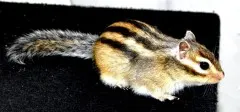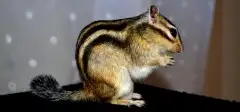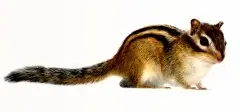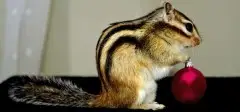Burundukas sibirinis
Burundukai – gražūs, gana tvarkingi ir protingi gyvūnėliai, tačiau kaip augintiniai reikalauja nemažai dėmesio ir kantrybės. Kadangi mėgsta daug judėti jiems reikia daug erdvės. Prieš įsigyjant burunduką reiktų gerai pagalvoti, ar galėsime tinkamai prižiūrėti, ar nesukels tai didelių rūpesčių, ar bus geros sąlygos jo laikymui.
Iš 25 burundukų rūšių, beveik visos, išskyrus Azijos Tamias sibiricus, randamos Šiaurės Amerikoje. Yra žinomos 5 sibirinio burunduko spalvinės gamos: labiausiai paplitusi dryžuota – šviesiai ruda su penkiom tamsiai rudos spalvos juostomis (angl. agouti – normal, brown, natural), cinamoninė (angl. cinnamon – red, ginger), balta su kreminės spalvos juostelėmis (angl. dilute), gryna balta su rausvomis akimis – albinosas (angl. Albino), taip pat gamtoje buvo pastebėta ir juoda. Kartais burundukai maišomi su trylikajuosčiu staru (Thirteen–Lined Ground Squirrel) arba (Golden–mantled ground squirrel). Skirtumas toks, kad burundukai yra mažesni už voveres ir turi juosteles viršuje ir apačioje akių.
Burundukai būna labai įvairių charakterių, nevisi jie būna mieli, kaip atrodo iš pirmo žvilgsnio. Reikia nepamiršti jog visi burundukai turi dantis ir nagus, kurie skirti ne tik rinkti maisto atsargas. Burundukų augintojai turėtų būti tokie žmonės, kurie mėgsta hyperaktyvius gyvūnus, ir tie, kurie gali maitinti savo augintinį šviežiais vaisiais ir daržovėmis. Burundukai nerekomenduojami mažiems vaikams, nes šie gyvūnai gali tapti baugštūs nuo vaikiško greito judėjimo ar staigių judesių. Jie netinka žmonėms, kuriems patinka augintinį priglausti prie savęs, nes burundukai mėgsta laisvai judėti ir nenustygsta vienoje vietoje. Jei burunduką auginti nuo pat jo gimimo jis gali tapti labai draugiškas.
Sibirinis burundukas yra visaėdis. Jis minta daržovėmis, medžių pumpurais, krūmų šakelėmis, grybais, riešutais, uogomis, taip pat kviečiais ir avižomis. Sibiriniai burundukai slepia maistą 5–8cm po žeme. Skleidžia įvairius garsus, taip pat ir cypsėjimą, kuris labai panašus į paukščių. Kadangi gamtoje jie gyvena medžiuose, jiems reikia didelio ir aukšto narvo. Narvas turėtų būti pakankamai didelis 120x90x90 cm(nenaudokite papūgų narvelių, jie yra gana reto tinklo). Narve turėtų būti įtaisyta daug šakų ir slėpimosi lizdelis, kuris turėtų būti su dviem skylėm, kaip su „atsarginiu išėjimu“, burundukui, dėl savisaugos instinkto. Narvo dugną galima iškloti medžio drožlėmis arba presuotomis medžio pjuvenų granulėmis. Narvelį reiktų išvalyti maždaug kas dvi savaites ir niekada nepalikti maisto atliekų, kurios greitai genda.
Siberian chipmunk
Chipmunks are beautiful, quite tidy and intelligent animals, but as pets they require a lot of attention and patience. Because they like to move a lot, they need a lot of space. Before buying a chipmunk, we should think carefully about whether we will be able to properly care for it, or whether it will not cause large problems worries about whether there will be good conditions for its storage.
Of the 25 species of chipmunks, almost all except the Asian Tamias sibiricus are found in North America. are known 5 color ranges of the Siberian chipmunk: the most common striped - light brown with five dark brown striped (English agouti – normal, brown, natural), cinnamon (English cinnamon – red, ginger), white with cream-colored stripes (English dilute), pure white with pink eyes - albino (English Albino), yes black was also observed in nature. Sometimes chipmunks are confused with the thirteen-tailed star (Thirteen–Lined Ground Squirrel) or (Golden–mantled ground squirrel). The difference is that chipmunks are smaller than squirrels and has stripes above and below the eyes.
chipmunks have very different characters, and not all of them are as cute as they seem at first glance. It is necessary don't forget that all chipmunks have teeth and claws, which are not only for collecting food supplies. Chipmunks breeders should be people who like hyperactive animals and those who can feed their own pet with fresh fruits and vegetables. Chipmunks are not recommended for small children because these animals can become fearful of the child's rapid movement or sudden movements. They are not suitable for people who like a pet close to you, because chipmunks like to move freely and do not stay in one place. If a chipmunk raised from birth, he can become very friendly.
The Siberian chipmunk is an omnivore. It feeds on vegetables, tree buds, bush twigs, mushrooms, nuts, berries, as well as wheat and oats. Siberian chipmunks hide food 5–8cm underground. Spreads various sounds, including chirping, which is very similar to birds. Since they live in trees in nature, they need a large and tall cage. The cage should be enough large 120x90x90 cm (do not use parrot cages, they are of rather thin mesh). The cage should be fitted with a lot branch and hiding nest, which should have two holes, like a „back-up exit“, chipmunk, due to the instinct of self-preservation. The bottom of the cage can be lined with wood chips or pressed sawdust pellets. The cage should be cleaned approximately every two weeks and never leave food waste that spoils quickly.
Burundukai yra jautrūs ir protingi gyvūnai, tačiau jie yra sunkiau prijaukinami. Norint prijaukinti burunduką reikia duoti iš rankų maisto. Labai mėgsta lazdynų riešutus, tačiau juos turbūt reikėtų duoti tik kaip skanėstą, gan retai kas 3–4 dienas. Renkantis burunduką reikia atkreipti dėmesį į jo sveikatą. Burundukas turėtų būti spindinčiomis akimis, žėrinčiu gražiu kailiu, būti aktyvus ir smalsus. Jei turite didesnį pasirinkimą, pasirinkite tą, kuris priartėja prie Jūsų pirmą kartą. Drąsiausi gyvūnai yra lengviausiai prijaukinami. Geriausias amžius prijaukinimui maždaug nuo 8 iki 16 savaičių. Tokiame amžiuje burunduką lengviau prijaukinti prie rankų. Burundukų gyvenimo tikslas yra kaupti greit negendančias maisto atsargas ir saugoti savo teritoriją, todėl nenustebkite jei jis gindamasis įkastu. Jokiu būdu nebarkite ir nemuškite vėliau bus tikrai sunku prisijaukinti ir atgauti pasitikėjimą.
Chipmunks are sensitive and intelligent animals, but they are more difficult to tame. To domesticate the chipmunk should be given food from the hands. He really likes hazelnuts, but they should probably be given only as a treat, rather rarely every 3–4 days. When choosing a chipmunk, you need to pay attention to it health. A chipmunk should have shining eyes, shiny beautiful fur, be active and curious. If you have a larger choice, choose the one that approaches you first. The bravest animals are the most easily domesticated. The best age for taming is around 8 to 16 weeks. In such a age, it is easier to tame a chipmunk by hand. The life purpose of chipmunks is to accumulate fast non-perishable food supplies and to protect its territory, so don't be surprised if it burrows in defense. Do not scold or hit in any way, later it will be really difficult to tame and regain trust.
Burunduku gana lengva rūpintis, tačiau jam reikia daug erdvės. Narvo aukštis turėtų būti nemažesnis nei 120cm ir 60cm pločio, o (metalinio) tinklo dydis nedidesnis nei 1,5cm x 2.5cm. Narvas turėtų eiti į aukštį, o ne į plotį. Kiekvienas burundukas turi turėti savo namelį (apie 15cm x 15cm x 15cm), kadangi nelinkęs dalintis su kitais. Jei vieno burunduko narvelyje yra daugiau namelių jis ko gero pasidarys tualetus ar maisto saugyklas. Narve turėtų būtinai būti bėgimo ratukas ir šakų laipiojimui. Rekomenduojama naudoti vaismedžių šakas (pvz. kriaušių), nes kitų rūšių medžių šakos gali būti toksiškos ir gali pakenkti burunduko sveikatai. Iš kitų rūšių tinka klevo, gluosnio ir ąžuolo. Taip pat narvelyje turėtų būti mineralų akmenukas(kreida) kuriais šlifuosis dantis, kadangi jie nenustoja augti(iš dalies tinka ir šienas) ir druskos (graužikams) šalia vandens gertuvės. Burundukai tuštinasi dažniausiai į vieną vietą (kampą), todėl nebūtina dažnai viso narvo išvalyti. Jei tuštinasi netinkamoje vietoje galima pamėginti pabarstyti ten maisto. Plaunant narvelį nederėtų naudoti jokių chemikalų kitu atveju reiktų gerai perplauti vandeniu. Rekomenduojama kas kelis mėnesius viduje narvelio pakeisti aplinką, kad nebūtų burundukams nuobodu ir liūdna. Jei mažieji augintiniai laipioja narvelio lubomis tai ženklas, kad jiems trūksta vietos ir reiktų išleisti iš narvelio palakstyti, tačiau kol neapsipranta su nauja aplinka nepatartina. Prieš paleidžiant reikėtų nepamiršti užkimšti visas patalpoje esančias angas, kur galėtų (neprijaukintas) burundukas pasislėpti.
The chipmunk is relatively easy to care for, but it needs a lot of space. The height of the cage should be no less than 120cm and 60cm wide, and the size of the (metal) net is no larger than 1.5cm x 2.5cm. The cage should go to height, not width. Each chipmunk must have its own house (about 15cm x 15cm x 15cm), because unwilling to share with others. If there are more houses in one chipmunk's cage, it will probably make one toilets or food storage. The cage should definitely have a running wheel and branches for climbing. Recommended use branches of fruit trees (e.g. pear), as branches of other types of trees can be toxic and can cause harm chipmunk health. Among other species, maple, willow and oak are suitable. It should also be in the cage mineral stone (chalk) with which the teeth will be polished, since they do not stop growing (partially also suitable hay) and salt (for rodents) near the water trough. Chipmunks usually defecate in one place (corner), so it is not necessary to clean the whole cage often. If they defecate in the wrong place, you can try sprinkle food there. No chemicals should be used when washing the cage, otherwise it should be fine rinse with water. It is recommended to change the environment inside the cage every few months to avoid chipmunks are bored and sad. If small pets climb the ceiling of the cage, it is a sign that they lack of space and should be let out of the cage to run around, but not until he gets used to the new environment not advisable. Before starting, you should remember to plug all openings in the room where possible (untamed) chipmunk to hide.
Burundukai minta įvairiu maistu. Jie mėgsta šviežius vaisius, daržoves, riešutus, sėklas, uogas, kirminus taip pat gėlių pumpurus, bei kitokius žalumynus. Būtinai reikia nuplauti visus šviežius produktus, kad pašalinti insekticidų likučius, o vaisių žieves reiktų nulupti. Švieži vaisiai ir uogos gali būti obuoliai, vynuogės, apelsinai, persikai, kriaušės ar slyvos (slyvų, nektarinų, abrikosų, persikų kauliukus reikia išmesti, nes juose gali būti nuodingų medžiagų). Daržovės gali būti morkos ir brokoliai. Pabandykite pasiūlyti įvairių vaisių ir daržovių, nes visi burundukai mėgsta skirtingą maistą. Vanduo turėtų būti visada šviežus ir švarus. Taip pat reiktų patikrinti ar vanduo tikrai galės lengvai tekėti iš gertuvės. Dažnai sakoma, kad negalima burundukams duoti maisto perdaug, tačiau burundukai likusį maisto perteklių, kuris greit negenda pasislepia ir kaupia. Burundukus erzina lipnus maistas pvz. kaip šviežios figos, nes kimba prie jų letenėlių, todėl kartais neima su jomis maisto. Kartais galima išgirsti burundukus valgant naktipiečius savo nameliuose.
Chipmunks eat a variety of foods. They like fresh fruits, vegetables, nuts, seeds, berries, worms as well as flower buds and other greens. Be sure to wash all fresh produce insecticide residues should be removed, and fruit peels should be peeled. Fresh fruits and berries can be apples, grapes, oranges, peaches, pears or plums (plum, pits of nectarines, apricots, peaches should be thrown away, as they may contain poisonous substances). Vegetables may include carrots and broccoli. Try to offer a variety of fruits and vegetables, because all chipmunks likes different food. The water should always be fresh and clean. It should also be checked whether the water will definitely be able to flow easily from the drinker. It is often said that you should not overfeed chipmunks, however, chipmunks hide and store the remaining food surplus, which does not spoil quickly. Chipmunks are annoying sticky food e.g. like fresh figs, because they cling to their paws, so sometimes they don't take food with them. Sometimes you can hear chipmunks eating dinner in their cabins.
Priešingos lyties burundukų poros, atrodo, yra labiausiai suderinamos. Burundukai dažnai mėgsta žaidimo forma muštis, tačiau jei tai atrodo rimta kova reiktų juos atskirti. Yra daug liūdnų istorijų kaip burundukus sumedžioja katės. Šunims galima mėginti uždėti antsnukį, tačiau ko gero net ir žaisdami gali sužeisti burunduką. Burundukai turėtų sutarti su šinšilom, galbūt paukščiais. Ko gero žuvytės nesukeltų jokių problemų.
Opposite-sex pairs of chipmunks seem to be the most compatible. Chipmunks often love to play form to fight, but if it looks like a serious fight, they should be separated. There are many sad stories like that chipmunks are hunted by cats. Dogs can be tried to be muzzled, but they can probably do it even while playing hurt the chipmunk. Chipmunks should get along with chinchillas, maybe birds. Perhaps the fish would not make any problem.
Jei ketinate veisti burundukus, svarbu atsižvelgti į keletą faktorių:
- 1. Ar jūsų narvas pakankamai didelis, kad sutalpintų visą pagausėjusią burundukų šeimyną ir, jei jūs ketinate parduoti mažylius, ar bus paprasta tai padaryti.
- 2. Ar jūsų turima gyvūnėlių pora tinkama veisimui. Geriausia, kad jau prieš įsigydami gyvūnus tai numatytumėte ir pasirinktumėte negiminingus burundukus.
- 3. Jei ketinate veisti burundukus su spalvinėmis mutacijomis (baltos ar cinamoninės spalvos), prireiks bent minimalių genetikos žinių.
Spalvinėms mutacijoms būdingas recesyvinis genas, o įprastiems tradiciniams burundukams dominuojantis, kas reiškia, kad suporavus tradicinį burunduką su baltu ar cinamoniniu visi pirmos kartos palikuonys bus tradicinės spalvos, tačiau vėlesnėse kartose dalis palikuonių jau bus balti ar cinamoniniai. Burundukai subręsta maždaug 1 metų. Veisimo laiką įtakoja sezoniškumas. Ilgėjant dienoms ir kylant temperatūrai, gyvūnų organizme vyksta hormoniniai pokyčiai. Įprastai burundukai poruojasi kovą–balandį ir dar kartą liepą–rugpjūtį. Tačiau uždarose patalpose laikomi burundukai neretai nemiega tikru žiemos miegu ir gali pradėti poruotis daug anksčiau. Todėl pasitaiko, kad atveda net tris vadas per metus. Tačiau tai nepatartina, kadangi gali pakenkti patelės sveikatai: ji nespės atgauti jėgų tarp vadų. Kai patelė yra pasirengusi poruotis, ji tai parodo skleisdama keistą čirpsėjimą ir papūtusi uodegą sukinėdamasi apie patinėlį. Nėštumas trunka 28–35 dienas. Jo metu patelė ruošia lizdą mažyliams, todėl reikia pasirūpinti, kad būtų pakankamai tam reikalingų medžiagų ir šiek tiek papildomo maisto, kurį ji galėtų pasislėpti, nes juo maitinsis pirmas pora dienų po gimdymo. Gimus mažyliams, kurį laiką nebandykite jų apžiūrėti, nes pajutusi pavojų patelė gali palikti mažylius ar, dar blogiau, juos suėsti. Mažyliai gimsta be kailio ir akli. Maždaug po 2 sav. jie jau būna su kailiuku, o po 26–28 dienų atanka. 5 sav. amžiaus pradeda ropštis iš lizdo, tad reikia pasirūpinti, kad būtų daug laipiojimui reikalingų priemonių prie pat jų namelio, kad jie galėtų pailsėti ir nenukristų. 6 sav. jie jau būna visai savarankiški, tačiau mama vis dar moko juos kaip susirasti maistą, sukti lizdą ir pan., todėl nereikėtų atskirti jų nuo patelės anksčiau kaip 8–10 sav.
If you are going to breed chipmunks, it is important to consider several factors:
- 1. Is your cage big enough to accommodate the entire extended family of chipmunks and if you you intend to sell the babies, will it be easy to do so.
- 2. Is the pair of pets you have suitable for breeding? It is best to do this before purchasing the animals you would predict and select unrelated chipmunks.
- 3. If you intend to breed chipmunks with color mutations (white or cinnamon), you will need at least minimal knowledge of genetics.
Color mutations are characterized by a recessive gene, while normal traditional chipmunks are dominant, which means that when a traditional chipmunk is mated with a white or cinnamon chipmunk, all the first generation offspring will be traditional colors, but in later generations some of the offspring will already be white or cinnamon. Chipmunks mature in about 1 year. Breeding time is influenced by seasonality. As the days grow longer and the rising rises temperature, hormonal changes occur in the animal's body. Normally, chipmunks mate March–April and again in July–August. However, it is not uncommon for chipmunks to be kept indoors does not hibernate and can start mating much earlier. Therefore, it happens that he brings even three commander per year. However, this is not advisable, as it can harm the health of the female: she will not be able to recover her strength between commanders. When the female is ready to mate, she shows it by making a strange chirp and puffing her tail circling around the male. Pregnancy lasts 28–35 days. During it, the female prepares a nest for the babies, therefore it is necessary to ensure that there are enough materials for this and some additional food which she could hide because she will be feeding on it for the first couple of days after giving birth. After the babies are born, for a while do not try to inspect them, as the female may abandon the babies or, worse, eat them if she feels threatened. Babies are born without fur and blind. After about 2 weeks they already have fur, and after 26–28 days attack 5 weeks age begins to crawl out of the nest, so you need to make sure that there is plenty for climbing the necessary facilities right next to their cabin so that they can rest and not fall. 6 weeks they are already quite independent, but mom is still teaching them how to find food, build a nest, etc., so shouldn't separate them from the female before 8–10 weeks.
Burundukai nelaisvėje gali išgyventi iki 10 metų ir daugiau. Moteriškos lyties gali gyventi iki devynių ar daugiau metų, tačiau vidurkis yra apie keturis. Patinai gyvena apie penkis, o vidutiniškai du–tris.
Chipmunks can live up to 10 years or more in captivity. Females can live up to nine or more years, but the average is about four. Males live about five, and on average two–three.
Lytinių organų srityje, patinėlis turės du iškilimus, toliau nuo išangės kurie yra maždaug vienas centimetras nuo kito. Patelės iškilimai turėtų būti labai arti išangės. Burundukų jauniklius gali būti sudėtinga atpažinti.
In the genital area, the male will have two protuberances, away from the anus, which are about one centimeter apart. The bumps of the female should be very close to the anus. Baby chipmunks can be difficult to recognize.
- Karalystė: Gyvūnai
- Gentis: Burundukai
- Būrys: Graužikai
- Tipas: Chordiniai
- Potipis: Stuburiniai
- Klasė: Žinduoliai
- Antklasis: Amniotai
- Šeima: Voveriniai
- Pošeimis: Tikrosios voverės
- Gyvenimo trukmė: 5–6 m
- Kūno ilgis: 12–18 cm
- Kingdom: Animals
- Genus: Chipmunks
- Squad: Rodents
- Type: Chords
- Subtype: Vertebrates
- Class: Mammals
- Superclass: Amniotes
- Family: Squirrels
- Subfamily: True Squirrels
- Lifespan: 5–6 m
- Body length: 12–18 cm
- Burundukas(lot. Tamias sibiricus, angl. Siberian chipmunk, vok. Asiatisches Streifenhörnchen) visaėdis (minta beveik viskuo).
- Reikalingas didelis narvas (min↑100 cm ↔90 cm ↓80 cm)
- Narvą valyti kuo dažniau ir nepalikti jame gendančių maisto atliekų.
- Gyvenimo trukmė priklauso nuo jų priežiūros (išgyvena iki ~10 m.)
- Prijaukinimas reikalauja nemažai kantrybės.
- Hyperaktyvūs gyvūnėliai vienišiai, saugojantys savo teritoriją.
- Burundukai neša laimę ir džiaugsmą žmonėms, bet jiems kaip ir visiems patinka laisvė
- The chipmunk (Latin Tamias sibiricus, English Siberian chipmunk, German Asiatisches Streifenhörnchen) is omnivorous (it eats almost everything).
- Large cage required (min↑100 cm ↔90 cm ↓80 cm)
- Clean the cage as often as possible and do not leave perishable food waste in it.
- Lifespan depends on their care (lives up to ~10 years)
- Domestication requires a lot of patience.
- Hyperactive solitary animals protecting their territory.
- Chipmunks bring happiness and joy to people, but like everyone else, they like freedom





